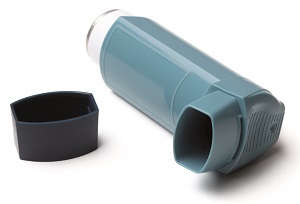There are a variety of inhalation devices on the market but they can all broadly be classified as either pressurised metered dose inhalers (pMDI) or breath-actuated inhalers. While inhalation will effectively reduce the incidence of side effects and treat symptoms, if a device fails to deliver the drug to the correct place the therapy is of no value at all. Current evidence suggests that up to 90% of patients using pressurised metered dose inhalers and up to 54% of patients using dry powder inhalers do not use their inhalers effectively and consequently do not experience the full benefit of their treatment.4 Patient education is key to treatment success.
There is a device currently on the market that can be used to help train patients on inhaler technique, the In-Check DIAL. This device works by measuring inspiratory flow and is preset with resistances corresponding to a variety of inhaler devices. The device allows patients to practise breathing in at the best rate and force to match their particular device and can be used with disposable mouthpieces to help patients with compliance.
 Pressurised metered dose inhalers (pMDI) are the standard mechanism for delivering drugs to the small airways in asthma. However, it is essential that the patient is educated in the use of the device and that this competence is checked at every opportunity. Patients using MDIs also need good coordination as lack of coordination between the activation of the device and inspiration is a problem not limited to children. pMDIs are also available as breath actuated inhalers, these are the Autohaler and Easi-Breathe devices.
Pressurised metered dose inhalers (pMDI) are the standard mechanism for delivering drugs to the small airways in asthma. However, it is essential that the patient is educated in the use of the device and that this competence is checked at every opportunity. Patients using MDIs also need good coordination as lack of coordination between the activation of the device and inspiration is a problem not limited to children. pMDIs are also available as breath actuated inhalers, these are the Autohaler and Easi-Breathe devices.
Patients should be educated on correct inhaler techniques to ensure they are maximising their treatment. For MDI users the most common problem is deposition of the drug in the oropharynx rather than the lungs caused by breathing in too fast and hard. Patients should be shown how to inhale slowly and steadily, as if taking a normal breath, as the device already contains the propellant which will push the drug towards the lungs. Breathing in too fast means that the majority of the dose will hit the back of the throat and not reach the lungs.
Spacer devices can be used with MDIs to help patients who struggle with the technique required. The spacer sits between the inhaler and the mouth, and it holds the medicine like a reservoir when the inhaler is pressed. A valve at the mouth end ensures that the medicine is kept within the spacer until the patient breathes in. When they breathe out, the valve closes. Good coordination is not needed to use a spacer device.
Spacers effectively slow down the particles and make coordination of actuation and inhalation much less critical. The main advantage of spacers is that they increase the proportion of the dose delivered to the airways whilst reducing the proportion absorbed into the body (usually the cause of side effects).
Spacer devices should be cleaned once a month using warm dilute soapy water, rinsed and allowed to drip dry. More frequent cleaning can lead to build up of electrostatic charge and affect drug delivery. The device should be replaced every 6-12 months.
Dry powder inhalers. This is the other main group of inhaler devices and includes Turbohalers and Accuhalers amongst others. Breath-actuated inhalers do not require the coordination of actuation and inhalation, making them suitable for patients who struggle with this aspect.
As with pMDIs, inhaler technique is still very important. Drug delivery to the lungs is dependent upon the patient's peak inhaled flow rate. Patients should be instructed on the hard, fast breath required to pull out the drug from the device into the lungs. Breathing in too slowly is the most common problem with these devices. This will result in the drug failing to reach the lungs, either being deposited in the oropharynx or not even leaving the device.
These devices do not contain any propellant and sometimes patients may complain that they are not certain a dose has been delivered. This could result in devices being discarded before they are empty or patients taking additional, unnecessary doses to compensate.
